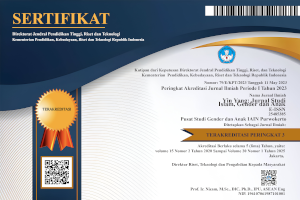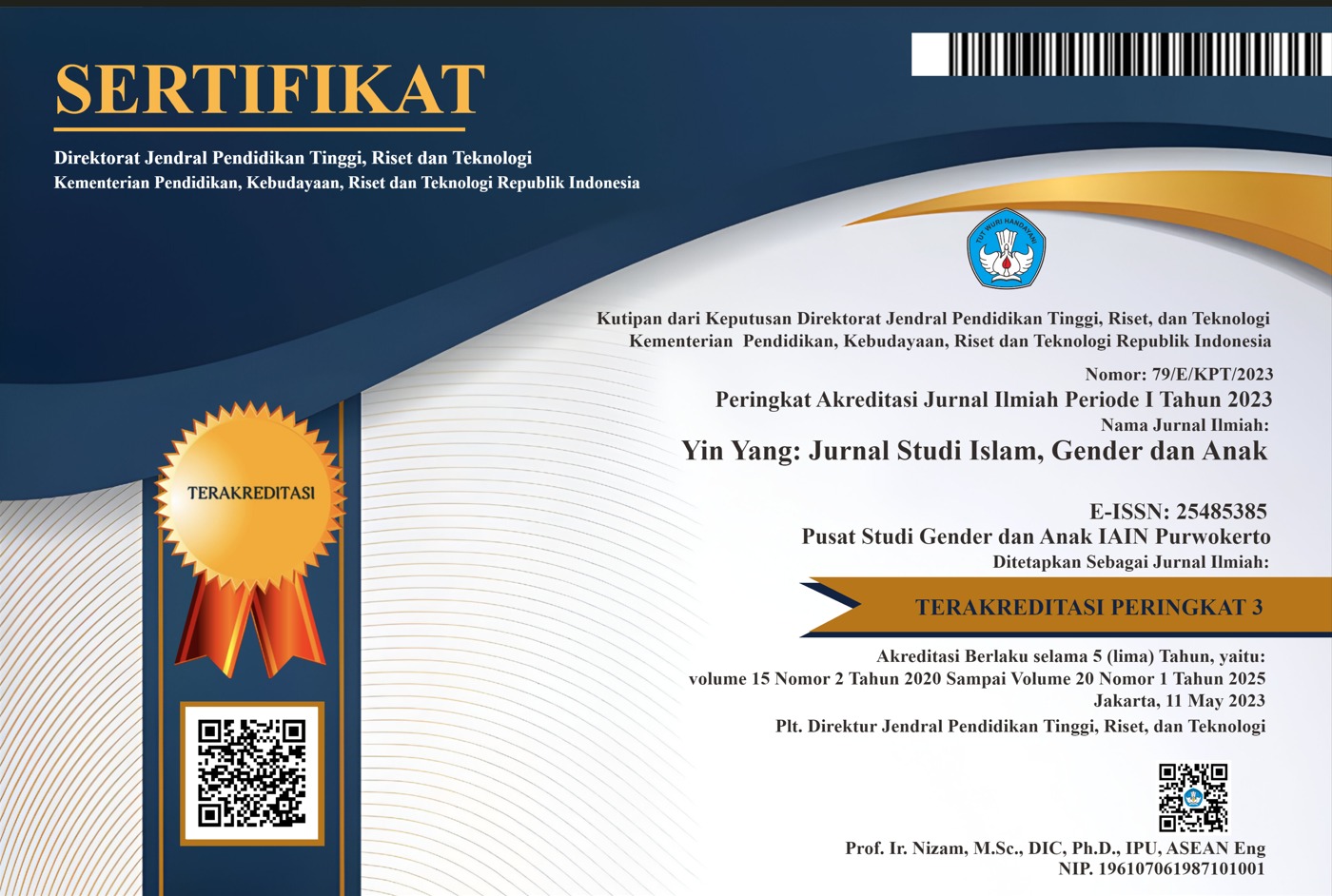Transposition of the Initial Creation of Women in the Qur’an to the Bible (Al-Kitab): Julia Kristeva’s Intertextuality Analysis
DOI:
https://doi.org/10.24090/yinyang.v19i1.9852Keywords:
Transposition, The Initial of Woman, Qur'an and Bibel (Al-Kitab)Abstract
This paper examines the Qur’ānic transposition of the concept in Bible (Al-Kitab) regarding the creation of women originating from the rib of men. This discussion does not seem to emerge from an explicit narrative in the Qur’anic text but rather from interpretations and hadiths narrated by Bukhari and Muslim. This study addresses two main questions: (1) What is the concept of the initial creation of women in the Qur’an and Al-Kitab? (2) How does the Qur’an transpose this concept to Al-Kitab? Using Julia Kristeva’s intertextuality approach, the research reveals that the transposition involves several elements: namely; the connection of substance or excerpt regarding the purpose of the creation of pairs to complement each other and produce offspring, the contradiction between the text of the Qur’an and Al-Kitab which contains elements of haplology occurs in the abrogation of the Qur’anic text which states that women come from the ribs of men, defamiliarization or changes in meaning conveyed by the Qur’an implicitly about the initial creation of women and demystification which occurs when the Qur’anic text changes the definition of the initial creation of women who are the same as men so that this difference creates Qur’anic opposition to the concept of Al-Kitab or conversion.Downloads
References
Daftar Pustaka
Adnan, T. (2011). Rekonstruksi Sejarah al-Qur’an. Devisi Muslim Demokratis.
Al-Ashfahani, A.-R. (2017a). al-Mufradat fi Gharibi Al-Qur’an, Jilid 1 (A. Z. Dahlan & R. Nurhadi (eds.)). Pustaka Khazanah Fawa’ id.
Al-Ashfahani, A.-R. (2017b). al-Mufradat fi Gharibi Al-Qur’an, Jilid 3 (A. Z. Dahlan & R. Nurhadi (eds.)). Pustaka Khazanah Fawa’ id.
Al-Jabiri, M. A. (2009). Fahm Al Qur’an al Hakim at Tafsir al Wadhih hasba Tartib an Nuzul, Jilid 3. Dar al Bayda.
Al-Qurtūbi, A. ‘Abdillah M. bin A. bin A. B. (2006). Al-Jāmi’ li Aḥkām Al-Qur’an, Juz 6. Muassasaḥ al-Risālaḥ.
Al-Zuhaili, W. (2009). Tafsīr al - Munīr fī al- ‘Aqīdah wa al - Sharī‘ah wa al - Manhāj, al-Mujallad 2 (Vol. 2). Darul Fikr.
Amrullah, A. A. (1989). Tafsir al-Azhar Jilid 2. Pustaka Nasional PTE LTD Singapura.
Basid, A. (2017). Asal Penciptaan Perempuan. Universum, 11(2), 115–122. https://doi.org/10.30762/universum.v11i2.696
Eko Zulfikar, A. Z. A. (2019). Penafsiran Tekstual Terhadap Ayat-Ayat Gender: Telaah Penafsiran Wahbah az-Zuhaili Dalam Kitab Tafsir al-Munir. Al-Quds: Jurnal Studi Al-Quran Dan Hadis…, 3(2), 135–156.
Hayati, S. M., Sofia, A., Zikri, A., & Siddiq, T. (2022). Interpretation of Ahlul Bait in Tafsir Al-Misbah Perspective of Intertextuality Julia Kristeva. Mashdar : Jurnal Studi Al-Quran Dan Hadis, 4(2), 259–274.
Hidayat, M. R. (2021). Kisah Yajuj Majuj dalam Tafsir Al-Azhar : Analisis Intertekstualitas Julia Kristeva. J-Alif : Jurnal Penelitian Hukum Ekonomi Syariah Dan Budaya Islam, 6(1), 45. https://doi.org/10.35329/jalif.v6i1.2206
Kaṡīr, I. (1998). Tafsīr Al-Qur’ān Al-’Aẓīm, al-Juz al-Ṡāni. Dārul Kutub ‘Ilmiyyah.
Khairunnisa, F. N. (2019). Kesetaraan Gender Menurut Pandangan Amina Wadud Dalam Penafsiran Penciptaan Perempuan Pertama [UIN Sunan Ampel Surabaya]. In PProdi Ilmu Al-Qur’an dan Tafsir Fakultas Ushuludin dan Filsafat UIN Sunan Ampel. http://digilib.uinsby.ac.id/30035/
Kristeva, J. (1980). Desire in Language: A Semiotic Approach to Literature and Art. In Poetics Today. Columbia University Press New York. https://doi.org/10.2307/1772011
Lajnah Pentashihan Mushaf Al-Qur’an. (2019). Al-Qur’an dan Terjemahannya (Edisi Peny). Badan Litbang dan Diklat Kementrian Agama.
Maesaroh, D. S. (2022). Penciptaan Perempuan Pertama dalam Al-Qur’an (Studi Komparatif Penafsiran Wahbah Az-Zuhaili dan Buya Hamka). Jurnal Penelitian Ilmu Ushuluddin, 2(2), 294–311. https://doi.org/10.15575/jpiu.v2i2.14510
Muhafizah. (2021). Penciptaan Alam Semesta Dalam Al-Qur’an dan Tanakh (Yahudi): Pendekatan Intertekstualitas Julia Kristeva. Jurnal Mafatih : Jurnal Ilmu Al-Qur`an Dan Tafsir, 1(2), 29–42.
Nuraini, S. (2019). Al-Quran dan Penciptaan Perempuan dalam Tafsir Feminis. Hermeneutik, 12(1), 71. https://doi.org/10.21043/hermeneutik.v12i1.6023
Nurhasanah. (2020). Pemikiran Hamka dan Nasaruddin Umar dalam Kesetaraan Gender. Al Tadabur: Jurnal Ilmu Alquran Dan Tafsir, 05(02), 281–296.
Randa, H. (2022). Manusia adalah Ciptaan Gambar Allah. LOGON ZOES: Jurnal Teologi, Sosial Dan Budaya, 5(1), 35–45. https://doi.org/10.53827/lz.v5i1.57
Riḍā, M. R. ibn ‘Ali. (1949). Tafsīr al-Manār, al-Juz al-Rabi. Dārul Manār.
Septiyani, V. I., & Sayuti, S. A. (2020). Oposisi dalam Novel “Rahuvana Tattwa” karya Agus Sunyoto: Analisis Intertekstual Julia Kristeva (Opposition in Agus Sunyoto’s “Rahuvana Tattwa” Novel: Julia Kristeva’s Intertextual Analysis). Lensa: Kajian Kebahasaan, Kesusastraan, Dan Budaya, 9(2), 174. https://doi.org/10.26714/lensa.9.2.2019.174-186
Shihab, M. Q. (2005a). Tafsir Al-Misbah (Kesan, Pesan dan Keserasian Al-Qur’an) Volume 1. In Lentera Hati. Lentera Hati.
Shihab, M. Q. (2005b). Tafsir al-Misbah (Pesan, Kesan dan Keserasian Al-Qur’an) Volume 12. Lentera Hati.
Shihab, M. Q. (2005c). Tafsir al-Misbah (Pesan, Kesan dan Keserasian Al-Qur’an) Volume 7. In Jakarta : Lentera Hati. Lentera Hati.
Sinaga, E. D. (2017). Pandangan Sains dan Alkitab tentang Asal-Usul dan Penanggalan Penciptaan Manusia. Jurnal Ilmiah Teologi, 1(1), 1–19.
Sulaeman, M. (2020). Reinterpretasi Hadist Mesoginik Tentang Penciptaan Wanita Dari Tulang Rusuk Laki-Laki. El-Faqih: Jurnal Pemikiran Dan Hukum Islam, 6(2), 18–37. http://ejournal.iaifa.ac.id/index.php/faqih/article/view/180%0Ahttps://ejournal.iaifa.ac.id/index.php/faqih/article/download/180/171
Wadud, A. (1999). Qur’an and Women. Oxford University.
Yayasan Lembaga SABDA. (2015). Alkitab SABDA. Https://Alkitab.Sabda.Org/Home.Php. https://alkitab.sabda.org/home.php
Downloads
Published
How to Cite
Issue
Section
License
Copyright (c) 2024 Aziz Bashor Pratama

This work is licensed under a Creative Commons Attribution-ShareAlike 4.0 International License.
Authors who publish with this journal agree to the following terms: Authors retain copyright and grant the journal right of first publication with the work simultaneously licensed under a Creative Commons Attribution-ShareAlike 4.0 International License that allows others to share the work with an acknowledgment of the work's authorship and initial publication in this journal.

















